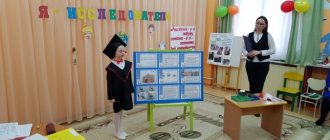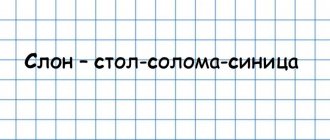Rituals for starting and ending classes in kindergarten
Rituals for starting and ending classes.
This is a very important moment in group work, contributing to the unity of participants, creating an atmosphere of group trust and acceptance, which is very important for fruitful and successful work with preschoolers. Rituals can be invented by the group during discussion or proposed by a psychologist. The beginning of a lesson should become a kind of ritual so that children can tune in to joint activities, communication, and distinguish these activities from others. The ritual can be changed, but not too often. The end of a lesson is the end of a certain type of activity, but not communication, so the ritual should, on the one hand, show that the lesson is over, on the other hand, show that the children are ready for constructive communication in the group and at home. The ritual can be the same, or it can be thematic. Rituals for starting classes.
- Game "Good morning"
Children stand in a circle, they are asked to learn a greeting that needs to be sung: - Good morning, Sasha! (Smile and nod your head.) Good morning, Masha! (Names are called, walks in a circle.) Good morning, Irina Nikolaevna! Good morning, sun! (Everyone raises their hands, lowers them.) Good morning, sky! (Similar movements) Good morning to all of us! (Everyone spreads their arms to the sides, then lowers them.)
- Game " Stand up, all of you..."
Educator. Stand up, everyone who loves to run, enjoys good weather, has a sister, loves to give flowers, etc.
- A game"Say hello cheerfully
"or
Game "Say hello to your neighbor as if you are afraid of him"
- Game "Circle Conversation"
Children and teacher sit in a circle. The teacher begins the sentence, and the children take turns, without interrupting each other, completing it. For example: “What I like most about myself is...”, “I would like to become...”, “My favorite game is...”, “What I fear most is...”, “Someday I hope...”.
- Game "Repeat the movement"
The children stand in a circle, the teacher offers to check before the trip whether the children know how to be one, because they will only go to the fairy tale together. Shows any movement, gesture with appropriate facial expressions, children must repeat.
- Game "Let's get to know each other"
The teacher says: “Stand in a circle, facing the center of the circle. Please, someone pick up the ball. In a circle, clockwise, starting from the one who has the ball, passing it, say your name clearly and loudly. When passing the ball, look your neighbor in the eye. Let's start! And now, while playing ball, we will get acquainted. The one who has the ball will throw it to any of those standing in the circle, and at the same time call the name of the person to whom the ball is addressed.
- Game “Greetings in an unusual way”
The teacher says: “Let's try to experience new emotions, and at the same time master unconventional greetings. You can come up with them yourself and show them to the whole group. To begin with, I offer several greeting options: with the back of the hand, feet, knees, shoulders, foreheads, etc.
- Game "Tell me about yourself"
The teacher selects an object (toy), shows it to the children and says that this object will be a symbol of our group, it will help us in everything. Today he will help us get to know each other. It is advisable for children to sit in a circle. The psychologist holds the object and tells the children about himself, then passes the symbol to the child sitting next to him, he also tells everything he considers necessary about himself, and so on in a circle. When the acquaintance is over, the children, together with the psychologist, choose the place where their symbol will be located. Then everyone agrees that before starting the lesson, they will hold each other's hands in a circle, with a symbol in the center. And everyone takes turns wishing everyone something good. This will be the greeting ritual in all classes.
- Game "Hello"
Clapping the child’s hands, the teacher greets him: “Hello, Alyosha!” The child, clapping the teacher’s hands in response: “Hello, Lena!” And so with each child, in turn.
- Game "Complete the task"
The teacher says: “Imagine that you are in a fairy forest. Take a look around. Birds sing, butterflies fly, beautiful flowers grow. The sun shines brightly. You feel the soft green lush grass under your feet. Breathe in the fresh air, the aroma of nature, listen to the sounds. You feel good and comfortable. Let's play a game. Everyone sit down on the chairs, as soon as you hear the command and find it in your place, you will have to complete the task. For example: Let everyone who is in a good mood today stand on their right leg. Let everyone with brown eyes clap their hands. Let everyone who has something pink in their clothes touch the tip of their nose. Let everyone who never offends others pat themselves on the head. Let everyone who knows how to help children and adults smile. Let those who do not call others names clap their hands
- Game "My Name"
Each child pronounces his name the way he would like to be called. The rest repeat the name in chorus with the same intonation that the “author” used. Next, the children say a greeting phrase to each other: “Roman, nice to see you.”
- Game "Signal".
Children stand (sit) in a circle, holding hands. The teacher transmits the “signal” by lightly pressing the hand of the child standing next to him on the right. The child who received the “signal” (with his left hand) must pass it to the person standing next to him with his right hand. Etc. in a circle until the “signal” reaches the leader, who at this moment can let out a joyful exclamation. The same is repeated in the other direction. When children have mastered this game, you can make it more complicated: - transmit a “signal” to children whose eyes are closed; -transmit a “signal” consisting of several hand presses (from 2 to 5 depending on the age of the children).
- Game "Magic Ball"
Children sit on chairs or on a carpet in a circle. The presenter passes the ball of thread to the child, who winds the thread around his finger and at the same time says a kind word, or a good wish, or affectionately calls the child sitting next to him by name, or says a “magic polite word,” etc. Then he passes the ball to the next child until it is the leader’s turn.
- Game "Good Animal".
Participants stand in a circle and join hands. The presenter says in a quiet voice: “We are one big, kind animal. Let's listen to how it breathes! Everyone listens to their breathing and the breathing of their neighbors. “Now let’s listen together!” Inhale - everyone takes a step forward, exhale - take a step back. “This is how the animal not only breathes, its big, kind heart beats just as smoothly.” Knock - step forward, knock - step back, etc.
- Game "Friendship begins with a smile."
Children sitting in a circle hold hands, look into their neighbor's eyes and silently smile at each other.
- Game "Compliments".
Sitting in a circle, everyone joins hands. Looking into your neighbor's eyes, you need to say a few kind words to him, praise him for something. The recipient of the compliment nods his head and says: “Thank you, I’m very pleased!” He then compliments his neighbor. If there is difficulty, the teacher can make a compliment or suggest saying something “tasty”, “sweet”, “flowery”. During the ritual, the teacher-psychologist is in a circle with the children, sets an example, gives hints, encourages, and sets the children up.
- The ritual of entering a lesson can be a simple greeting, both for kids and older preschoolers:
- Good morning, sun! (children raise their hands, then lower them) - Good morning, sky! (children raise their hands, slightly spreading them to the sides) - Good morning, to all of us! (children put their hands to their chest)
- Here is the next greeting, which is carried out in the form of a dialogue between an adult and children.
Educator.
Good morning!
Children.
Good morning!
Q.Are
you all healthy?
D.
Yes!
We are healthy! Q.
Glad to see you!
D.
Glad to see you!
Q.What
are we going to do?
D.
Let's study!
B.And
then play and have fun!
19.
.
Here are a few more options for getting into the lesson: 1.
Children, standing in a circle, say to their neighbor on the right: “I’m glad to see you, Vadim!”
and hug each other. And since we are happy to see each other, it means that we are in a good mood and it will be interesting for us to study. 2.
Children, standing in a circle, put their hands on the shoulders of their comrades and recite the chant:
Only the brave and persistent will get to the goal cheerfully, And on the road you need to know the secrets of lasting friendship. Then they join their right hands in the center of the circle, placing one hand on the other, saying the motto “One for all and all for one!” After which the teacher says that the spoken words will help to overcome all the difficulties that will be encountered during the lesson. 20
The teacher invites those children to sit down who say words related to the topic of the lesson. For example, the lesson “Description of a toy”, respectively, children name a toy, and then sit down on a chair.
End of class rituals
- Game “Warmth of hands and hearts”
Children stand in a circle and pass their name to their neighbor in the palm of their hand, smiling with the kindest smile. A teacher-psychologist asks children to give him something as a farewell gift! You have nothing with you, but you have the warmth of your hearts, which you can feel is the warmth of your palms. Handshake in a circle.
- Game "Compliments"
Children in a circle, everyone joins hands. Looking into your neighbor’s eyes, say a few kind words, thank him for something (either for what happened in class today: (careful, answered well, told an interesting story) or note the qualities that are attractive in him (smart, beautiful eyes, hair and etc.) An understanding compliment nods his head and thanks: “Thank you, I’m very pleased!” - then he says a compliment to his neighbor. The exercise is carried out in pairs.
- Game "Farewell"
Participants stand in a circle and place their hands on each other's shoulders. They look at each other friendly and say: “Thank you, goodbye.”
- Game "We'll Meet Again"
All children stand together in a circle, extend their left hand forward “from the heart, from the soul” (it turns out to be a pyramid of palms) and say the traditional words: “One, two, three, four, five - we’ll meet again soon!”
- Exercise “Thank you for the pleasant activity.”
Teacher: “Guys, our journey through the fairy forest is ending, and I want to invite you to thank each other for your journey through the fairy forest. One of you stands in the center of the circle, the other comes up to him, shakes his hand and says: “Thank you for a pleasant trip!” Both remain in the center, still holding hands. Then the third participant comes up, takes either the first or the second by the free hand, shakes it and says: “Thank you for a pleasant trip!” - thus, the group in the center of the circle gradually increases. Everyone is holding each other's hands. When the last person joins your group, close the circle and end the ceremony of gratitude with a silent, gentle shake of hands three times.”
- Game "Circle of Friends"
Standing or sitting in a circle, everyone should take hands, shake them, look at everyone in turn.
- Game "Friendship Relay".
Hold hands and pass a handshake like a baton. The teacher begins: “I will convey my friendship to you, and it goes from me to Masha, from Masha to Sasha, etc., and finally returns to me again. I feel like there is more friendship as each of you added a piece of your friendship. Let it not leave you and warm you. Goodbye!"
- Game "Sun Rays"
Stretch your hands forward and join them in the center of the circle. Stand quietly, trying to feel like a warm ray of sunshine.
- Speech
We are all friendly guys. We are preschool children. We don't offend anyone. We know how to care. We will not leave anyone in trouble. We won’t take it away, we’ll ask for it. Let everyone be well, May it be joyful and light!
Video: lesson notes.
Most of the activities for preschoolers are educational and also contain elements of art, familiarization with the environment, and, of course, physical exercises (dynamic pauses) and games.
Many works are located in several sections of this section at once, since they combine several areas. So, for example, classes in art are a general section, while classes in drawing or modeling are specific categories. However, when publishing, it is advisable to indicate all categories of headings related to your material for a more convenient search. Additionally, we suggest filling out sections that sort notes by topic. Then, when preparing a lesson with your children, you can use ready-made lesson notes. For example, in the “toy topic” section, you can find all activities related to toys in one way or another.
If you want your entry to be included in this section, when publishing, select the “ class notes”
,” and additional subsections.
All sections
Structure of classes with preschool children
How to write a resume for a student without work experience
Teaching preschool children
is visually effective. The child acquires new knowledge on the basis of direct perception, when he watches the teacher’s actions, listens to his explanations and instructions, and acts with the didactic material himself.
“Tell me and I’ll forget, show me and I’ll remember, let me do it and I’ll understand.”
(Confucius)
The lesson begins not at the desks, but with the children gathering around the teacher. In younger groups, children can, for example, sit on chairs in a semicircle in front of the teacher.
Lesson structure at a younger age
1. Introductory part. Classes often begin with game elements, surprise moments - the unexpected appearance of toys, things, the arrival of “guests” or fairy-tale plots. This interests and activates the kids. (3 – 4 min)
2. The main part of the lesson. Learning new material or consolidating previously learned material. This stage occurs using a didactic game and working with handouts. (8 – 10 min)
3. Summing up. Be sure to praise the children for the work they have done. (2 minutes)
In the middle of the lesson, you should do a physical training session.
Class structure in middle age.
1. Introductory part. Classes begin with a didactic game, surprise moments, a problem situation, artistic expression (2 - 3 min.)
2. Studying new material (10 - 12 min).
3. Repetition of previously studied material (4 – 6 min).
4. Summing up. In the middle group, at the end of the lesson, the teacher himself sums up the lesson, introducing the children. (“What did we learn new today? What did we talk about? What did we play?”). (2 – 3 min)
After studying new material, it is advisable to conduct a physical training session.
Structure of classes at older ages.
Option 1.
1. Introductory part. Checking children's readiness for class. Creating interest in the lesson (2 - 3 min)
2. Repetition to introduce children to a new topic. A group of children usually sits at desks in twos, facing the teacher, as they work with handouts and develop learning skills. (3 – 5 min.)
3. Consideration of new material. In older groups, it is advisable to use problem situations. (12 – 15 min)
4. Repetition of learned material. (5 – 7 min.)
After studying new material, you should do a physical training session.
Option 2.
- Organizing time.
- Continuation of work on studying a new topic.
- Continued study of immediately preceding material or its consolidation.
- Repetition of what was previously covered.
- Summarizing.
The gradual increase in complexity of program material and methodological techniques aimed at mastering knowledge and skills allows children to feel success in their work, their growth, and this, in turn, contributes to the development of their increasing interest in their studies.
REMEMBER!
The leading activity in preschool age is play.
. During classes, use didactic, developmental and outdoor games.




